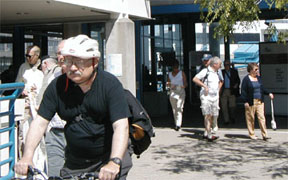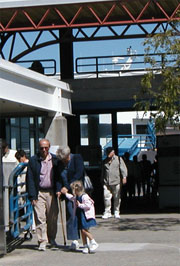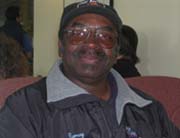
THERIDERS
Ferry Riders Choose a Traffic-Free,
Stress-free Commute

Sunlight glints off the water as the aroma of fresh-
brewed coffee fills the air. You sit back, read the newspaper or a
novel, catch up on phone calls, prepare for a meeting, chat with
fellow passengers, or just relax and enjoy the ride.  While this is not
the typical experience for commuters, it is the experience of
thousands who choose to travel by ferry. Instead of sitting in traffic
on overcrowded freeways, many Bay Area residents leave the driving to
the captain
While this is not
the typical experience for commuters, it is the experience of
thousands who choose to travel by ferry. Instead of sitting in traffic
on overcrowded freeways, many Bay Area residents leave the driving to
the captain
Among its objectives, the Water Transit Authority (WTA)
is looking to lure single-occupancy drivers out of their cars and into
the ferry, thus decreasing traffic on Bay Area roads and bridges. To
create a transit system that people will want to ride, the WTA’s
consultants, Cambridge Systematics, to surveyed 3,000 ferry passengers
and 850 potential ferry riders to get a clear picture of how people
choose among their commute options. Rather than merely focusing on
time and money as traditional transit surveys have done, the WTA added
in motivators that were likely to apply to ferry riders, including
sensitivity to stress, environmental concerns, personal safety, and
crowds.
Ferry Riders Share Their Experiences
For this article, the WTA spoke informally with some
ferry riders to get a snapshot of their reasons for commuting by boat.
Not surprisingly, these riders spontaneously mentioned travel time,
stress reduction and protecting the environment as part of the reason
they choose to commute by ferry.
 |
| James George
says that the ferry is the only available transit option he
would choose over driving. |
“Taking the ferry to work is the most pleasant
part of my day,” explained James George, a consultant living in
Alameda. “I can read, socialize and be outdoors. The staff is very
personable. If the ferry wasn’t available I’d have to drive into
the City.” Mr. George indicated that he was disinclined to take
other transit options that were available to him because they made him
feel too claustrophobic.
Susan McDuffie, a manager in San Francisco, commutes
from Alameda every day. Typical of many ferry riders who enjoy the
space and quiet time that a ferry provides, she said “It’s
convenient and the scenery is pleasant. I can stretch out, read the
newspaper and have a cup of coffee - something I wouldn’t be able to
do otherwise.”
 |
| Willie Ramsey
purposely arranges his work schedule so that he can commute to
work on the ferry. |
Willie Ramsey is a deckhand who arranges his work
schedule so that he can travel to and from work between Alameda and
San Francisco on the ferry. Mr. Ramsey would have to drive to work if
the ferry wasn’t available. “If I had to drive, I would be more
tense and my commute time would be longer,” he explained. “And I
wouldn’t be able to read the paper or take a quick nap.”
David Pauley identified “The bar, view and
bathrooms,” as the three best things about the ferry. Because he has
to arrive early at his job as head chef for a San Francisco
restaurant, in the mornings, he takes an express bus that picks him up
in front of his apartment in San Rafael. However, after a day’s
work, he prefers the relaxing experience of taking the nighttime ferry
from San Francisco to Larkspur. Since the Golden Gate Ferry Service
operates shuttle service to complement its ferry service, he takes
advantage of convenient bus connections in Larkspur to take him to
downtown San Rafael, where he either walks or takes a short cab ride
home. Although Mr. Pauley uses the ferry for everyday transportation,
he never fails to take out-of-town visitors on the ferry ride for fun
and to bask in their envy at his commute.
The WTA is working with Bay Area transportation
agencies to determine how to provide reliable, easy transit
connections to and from ferries, similar to those enjoyed by Golden
Gate Ferry users. Of course, walking, biking, or taking transit to the
terminal will help maximize the environmental benefits of commuting by
ferry. The WTA is planning to provide the best terminal access to
those who arrive by those modes of transit. Everyone interviewed
agreed that protecting the environment is an important consideration.
 |
| Amber Jones and Gerda Frey might
not be friends today if it weren’t for the ferry. |
Two Kinds of Good Connections
Apart from making good transit connections, the WTA
discovered that good social connections are a benefit for ferry
riders. For instance, Amber Jones and Gerda Frey are ferry commuter
buddies who met three years ago on the ferry. They share the same
morning ride on the Del Norte from Larkspur to San Francisco, but take
different return boats in the afternoon. Each morning, they stake out
the same table on the starboard side/front of the Del Norte’s upper
deck, each gets a cup of coffee, and then they sit, chat with each
other and with a couple of other regular commuter friends who sit with
them.
Having moved to the Bay Area from England three
years ago, Ms. Jones works as a talent agent in San Francisco. She
gets a ride to the Larkspur ferry terminal in the morning, then
connects with San Francisco MUNI to reach her final destination. Ms.
Frey moved to the Bay Area 14 years ago, also from Europe. She works
as an executive assistant at a company within walking distance to San
Francisco’s ferry terminal. They both concurred that ferries were
“reliable and much less stressful than driving.” Ms. Jones added
that, “The ferry does take longer than driving, but parking is so
difficult and expensive in San Francisco that it’s much better to
take the ferry.”